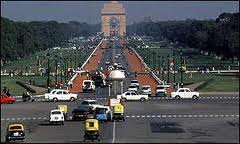 A neighbour’s teenaged children leave home every evening for about an hour when it’s time for him to come home. Visits to friends, trips to the market, or to the sports complex, are all scheduled around this time to avoid Dad, who comes home spitting and snarling as a result of having battled Delhi’s office rush hour traffic on his 20 kilometre daily work commute, ever since the driver quit his job a month ago. His wife wishes she could follow suit! The situation is worse for multiple income families where almost everyone is fit to be tied by the time they make it home!
A neighbour’s teenaged children leave home every evening for about an hour when it’s time for him to come home. Visits to friends, trips to the market, or to the sports complex, are all scheduled around this time to avoid Dad, who comes home spitting and snarling as a result of having battled Delhi’s office rush hour traffic on his 20 kilometre daily work commute, ever since the driver quit his job a month ago. His wife wishes she could follow suit! The situation is worse for multiple income families where almost everyone is fit to be tied by the time they make it home!
As traffic-related problems rise exponentially in the Capital, driver woes have surpassed maid servant laments as the prime topic of conversation among Delhiites (a raw nerve for the commuters as well as for the members of their households), even as ‘traffic-talk’ has become the standard drawing room conversation. The incidence of road rage is the highest in NCR Delhi among all Indian cities, including as it does, numerous instances of street brawls, broken limbs, and not too long ago, even a murder! Parking space is another nightmare that Delhi’s denizens face regularly, be it within their own colonies, or outside.
Small wonder, when Delhi NCR, apart from its own population of about 19 million, and a population density of more than 9000 persons per square kilometres, also houses an extensive expatriate population, and accommodates thousands of commuters from outlying areas who come to work in the city every day. Delhi has a car density of 85 cars per 1000 persons—roughly 10 times the national average, and 1992 kilometres of road per 100 square kilometres, as against the nation’s average of 74! And these figures don’t come anywhere near explaining the chaos that reigns on the Capital’s roads 24×7.
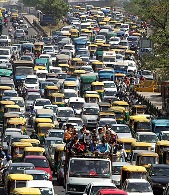
For one, they do not spell out the fact that most car-owning households have almost as many cars as members. The entry of all the automotive majors of the world into India post-liberalization, coupled with the fact that Delhi is near the top in the tally of per capita incomes and has arguably the highest incidence of bandwagon hopping, has spawned an upsurge in car-loans, and consequently, the number of cars. Nearly 3.5 lakh cars are added to the roads of the Capital every year!
Second, they cannot depict the fact that flyovers that have literally mushroomed all over the capital, have merely become fresh points of traffic congestion, not only because of the sheer volumes and numbers being added on a continuous basis, but also because during the peak rush hours, there are usually a couple of broken down trucks/ buses/ tempo carriers causing traffic snarls for miles and miles!
Further, the statistics do not capture the fact that since almost as much of NCR Delhi’s population lives in slums and ‘semi-rural’ settlements as in posh colonies, bungalows, mansions and apartment complexes, the traffic clogging its roads at all hours of the day and night has multifarious, heterogeneous elements, that turn the act of driving through it into a nightmare on wheels!
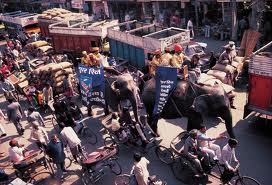 It is impossible to explain in terms of figures the proliferation of two-wheeler and three- wheeler passenger vehicles, and buses of all descriptions—DTC (both AC and non-AC) as well as private (school buses, tourist coaches, interstate buses and private stage carriages—yes, the rogue Blue Line buses, though officially phased out, still continue to ply nonchalantly, though in smaller numbers than before); not to mention the hoi polloi of cycle rickshaws, bicycles, RTVs, three-wheeler carriers, tempos, trucks, tractors, horse and bullock carts, occasional camels and elephants, construction cranes, cement mixers, dumpers, and tractors with wagons that populate the roads of Delhi. And they could be carrying anything—a load of potatoes or cabbages, a contingent of cars, livestock, garbage from colonies to the landfills, construction material, furniture, or even villagers en route to a political rally or a festive occasion!
It is impossible to explain in terms of figures the proliferation of two-wheeler and three- wheeler passenger vehicles, and buses of all descriptions—DTC (both AC and non-AC) as well as private (school buses, tourist coaches, interstate buses and private stage carriages—yes, the rogue Blue Line buses, though officially phased out, still continue to ply nonchalantly, though in smaller numbers than before); not to mention the hoi polloi of cycle rickshaws, bicycles, RTVs, three-wheeler carriers, tempos, trucks, tractors, horse and bullock carts, occasional camels and elephants, construction cranes, cement mixers, dumpers, and tractors with wagons that populate the roads of Delhi. And they could be carrying anything—a load of potatoes or cabbages, a contingent of cars, livestock, garbage from colonies to the landfills, construction material, furniture, or even villagers en route to a political rally or a festive occasion!
All these diverse components of Delhi’s traffic ply blithely at their own varied, merry paces, regardless of frivolities such as traffic rules, red lights, lanes, overtaking norms, free left turns, and of others sharing the road with them! Enforcement of traffic rules seems to be an unheard-of concept (at least ever since Dr Kiran (Crane) Bedi was relieved of the charge of Delhi’s Traffic Police), and traffic cops have a field day, reeling in prime ‘catches’ for their ‘private collection’, especially around festival time. There have been observed instances of pedal-happy drivers brazenly jumping signals, sticking out their arms to pass a currency note to the traffic cop on duty with practised ease, without even bothering to slow down!
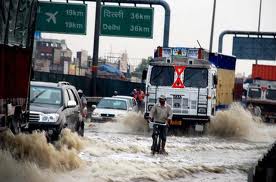 Plus, the state of the city’s infrastructure, be it roads or drainage, ensures that the first showers wash away major chunks of the best roads and flood what is left of them, leaving the increasingly congested traffic floundering on waterlogged rutted thoroughfares! It is not uncommon for a 10 kilometre commute to take as much as an hour in normal rush-hour traffic, and up to two hours on a rainy day!
Plus, the state of the city’s infrastructure, be it roads or drainage, ensures that the first showers wash away major chunks of the best roads and flood what is left of them, leaving the increasingly congested traffic floundering on waterlogged rutted thoroughfares! It is not uncommon for a 10 kilometre commute to take as much as an hour in normal rush-hour traffic, and up to two hours on a rainy day!
The Metro is already overcrowded to the extent that guards have occasionally been observed stuffing in stray arms and legs sticking out of carriages, to enable the doors to close and the train to move! It is unlikely that the Metro, even when upgraded to its planned 200 km of track length as 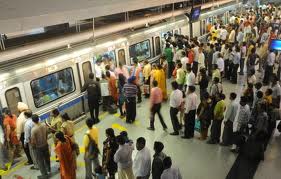 opposed to the present 100 km, would be enough for the commuter population of the city. The Bus Rapid Transit System (BRTS), which might have introduced some sort of method into the madness that is Delhi’s traffic, failed spectacularly at the inception and may not be given another chance.
opposed to the present 100 km, would be enough for the commuter population of the city. The Bus Rapid Transit System (BRTS), which might have introduced some sort of method into the madness that is Delhi’s traffic, failed spectacularly at the inception and may not be given another chance.
The pot holes on the roads would be almost funny, if only they, amongst other reasons, had not earned for Delhi, the doubtful distinction of the slowest traffic in the country, with an average speed of 15 kmph (Mumbai comes second at 18 kmph). It seems wiser to either stay at home or walk to destinations less than 2-3 kilometres away, even if it means tying moistened handkerchiefs around the nose and mouth to filter out the noxious traffic fumes. The traffic travails also seem to have revived some variant of the purdah system, as women forced to negotiate the roads on foot muffle themselves in dupattas, stoles or scarves to minimize the damage to their skin and hair.
Delhi is crying out for better road infrastructure, a much larger Metro network and stringently enforced traffic rules. The vocabularies of those who drive regularly on the roads of the Capital are generally among the most colourful in the world, and it is not hard to see why!






Good piece, ‘good’ (? maybe not the right word ) stats. It would be easy to extrapolate this vison to Chennai I’m afraid – and the Metro isnt finished here yet. Tatas dream of the Nano replacing 2 wheelers means safety -no longer would INdians need to risk life and limb taking a family of 4 plus a wardrobe on motorbike – but it would also excacerbate the current congestions to complete standstill. If the migration levels from urban areas to cities in India continues at its current alarming and ever increasing rate an even more serious situation is inevitable. Good piece, thanks !
Thanks Ian … this article comes straight from the heart, I assure you 🙂
Very timely read Parul, my first day in Delhi’s gnarly snarly traffic this morning accompanied by three Indian children who were thinking of ways to improve their city…they talked about education – a lack of – infrastructure and corruption as being the biggest hurdles and were very well aware of the problems of the city they are about to inherit as adults!! Scary watching motorcycles weaving in and out of traffic gnarls, it made me wonder how many people die on the road in Delhi just trying to get between work and home.